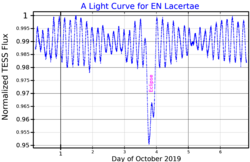 A light curve for EN Lacertae, plotted from TESS data | |
| Observation data Epoch J2000.0 Equinox J2000.0 | |
|---|---|
| Constellation | Lacerta |
| Right ascension | 22 56 23.62929 |
| Declination | +41° 36′ 13.9482″ |
| Apparent magnitude (V) | 5.587±0.015 |
| Characteristics | |
| Spectral type | B2 IV + F6–7 + F0 |
| Variable type | β Cep + Algol |
| Astrometry | |
| Radial velocity (Rv) | −12.45±0.04 km/s |
| Proper motion (μ) | RA: −1.188 mas/yr Dec.: −4.290 mas/yr |
| Parallax (π) | 2.0692 ± 0.0865 mas |
| Distance | 1,580 ± 70 ly (480 ± 20 pc) |
| Absolute magnitude (MV) | −2.67±0.14 |
| Orbit | |
| Period (P) | 12.0969 d |
| Eccentricity (e) | 0.0539±0.0026 |
| Periastron epoch (T) | 61.4±2.1 |
| Semi-amplitude (K1) (primary) | 23.85±0.05 km/s |
| Details | |
| 16 Lac A | |
| Mass | 9.5±0.03 M☉ |
| Radius | 5.6±0.4 R☉ |
| Luminosity | 7,762+1,151 −1,002 L☉ |
| Surface gravity (log g) | 3.95±0.05 cgs |
| Temperature | 23,000±200 K |
| Metallicity | 0.00±0.08 dex |
| Rotational velocity (v sin i) | 12±1 km/s |
| Other designations | |
| 16 Lac, EN Lac, BD+40° 4949, HD 216916, HIP 113281, HR 8725, SAO 52512 | |
| Database references | |
| SIMBAD | data |
16 Lacertae is a triple star system in the northern constellation of Lacerta, located about 1,580 light years from the Sun. It has the variable star designation EN Lacertae; 16 Lacertae is the Flamsteed designation. This system is visible to the naked eye as a faint blue-white hued star with a maximum apparent visual magnitude of +5.587. It is moving closer to the Earth with a heliocentric radial velocity of –12 km/s.
The binary nature of the brighter component was discovered in 1910 by astronomer Oliver J. Lee at Yerkes Observatory. The first orbital elements were published by Otto Struve and Nicholay T. Bobrovnikov in 1925. This is a single-lined spectroscopic binary with an orbital period of 12.1 days and a small eccentricity of 0.05. It forms an eclipsing binary variable, although only the eclipse of the primary component has been detected. This component is a Beta Cephei variable star with three dominant pulsation modes having frequencies of around six per day. It has a stellar classification of B2 IV, matching a B-type subgiant star with 9.5 times the mass of the Sun and 5.6 times the Sun's radius.
The unseen secondary is an F-type star of class F6–7. The tertiary component is a magnitude 11.4 star with a class of F0. As of 2008, it was located at an angular separation of 27.6″ from the primary.
References
- "MAST: Barbara A. Mikulski Archive for Space Telescopes". Space Telescope Science Institute. Retrieved 8 December 2021.
- ^ Brown, A. G. A.; et al. (Gaia collaboration) (August 2018). "Gaia Data Release 2: Summary of the contents and survey properties". Astronomy & Astrophysics. 616. A1. arXiv:1804.09365. Bibcode:2018A&A...616A...1G. doi:10.1051/0004-6361/201833051. Gaia DR2 record for this source at VizieR.
- ^ Nieva, María-Fernanda; Przybilla, Norbert (2014). "Fundamental properties of nearby single early B-type stars". Astronomy & Astrophysics. 566: A7. arXiv:1412.1418. Bibcode:2014A&A...566A...7N. doi:10.1051/0004-6361/201423373. S2CID 119227033.
- ^ Lesh, Janet Rountree (December 1968). "The Kinematics of the Gould Belt: an Expanding Group?". Astrophysical Journal Supplement. 17: 371. Bibcode:1968ApJS...17..371L. doi:10.1086/190179.
- ^ Eggleton, P. P.; Tokovinin, A. A. (September 2008). "A catalogue of multiplicity among bright stellar systems". Monthly Notices of the Royal Astronomical Society. 389 (2): 869–879. arXiv:0806.2878. Bibcode:2008MNRAS.389..869E. doi:10.1111/j.1365-2966.2008.13596.x. S2CID 14878976.
- ^ Jerzykiewicz, M.; et al. (2015). "The 2003–2004 multisite photometric campaign for the β Cephei and eclipsing star 16 (EN) Lacertae with an appendix on 2 Andromedae, the variable comparison star". Monthly Notices of the Royal Astronomical Society. 454 (1): 724–740. arXiv:1508.05250. Bibcode:2015MNRAS.454..724J. doi:10.1093/mnras/stv1958. S2CID 119220117.
- Samus, N. N.; et al. (2017). "General Catalogue of Variable Stars". Astronomy Reports. 5.1. 61 (1): 80–88. Bibcode:2017ARep...61...80S. doi:10.1134/S1063772917010085. S2CID 125853869.
- ^ Pourbaix, D.; et al. (2004). "SB9: The Ninth Catalogue of Spectroscopic Binary Orbits". Astronomy & Astrophysics. 424: 727–732. arXiv:astro-ph/0406573. Bibcode:2004A&A...424..727P. doi:10.1051/0004-6361:20041213. S2CID 119387088.
- Lehmann, H.; et al. (February 2001). "A new analysis of the radial velocity variations of the eclipsing and spectroscopic binary EN Lacertae". Astronomy and Astrophysics. 367: 236–249. Bibcode:2001A&A...367..236L. doi:10.1051/0004-6361:20000344.
- ^ Nieva, M.-F.; Przybilla, N. (2012). "Present-day cosmic abundances. A comprehensive study of nearby early B-type stars and implications for stellar and Galactic evolution and interstellar dust models". Astronomy & Astrophysics. 539: A143. arXiv:1203.5787. Bibcode:2012A&A...539A.143N. doi:10.1051/0004-6361/201118158. S2CID 119206639.
- "16 Lac". SIMBAD. Centre de données astronomiques de Strasbourg. Retrieved 2019-02-02.
- Struve, O.; Bobrovnikoff, N. T. (September 1925). "Orbit of the spectroscopic binary 16 Lacertae". Astrophysical Journal. 62: 139–143. Bibcode:1925ApJ....62..139S. doi:10.1086/142919.
| Constellation of Lacerta | |||||||||||
|---|---|---|---|---|---|---|---|---|---|---|---|
| Stars |
| ||||||||||
| |||||||||||
| |||||||||||
| Galaxies |
| ||||||||||